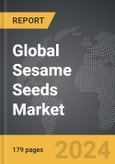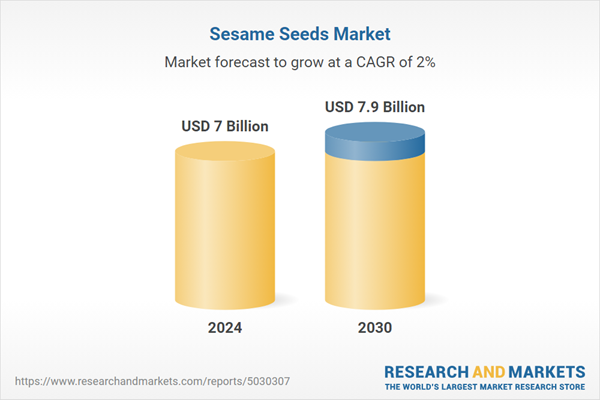Global Sesame Seeds Market - Key Trends and Drivers Summarized
Why Are Sesame Seeds Gaining Popularity in the Global Market?
Sesame seeds are gaining significant popularity in the global market due to their high nutritional value, rich flavor, and versatility in culinary applications. Known for their high content of essential nutrients such as healthy fats, protein, fiber, vitamins, and minerals, sesame seeds are increasingly being recognized as a superfood with numerous health benefits, including heart health, bone strength, and immune support. The growing awareness of these health benefits is driving the demand for sesame seeds in various food and beverage products, such as bakery items, snacks, confectioneries, sauces, and condiments. Additionally, the rise of vegan, gluten-free, and plant-based diets is further propelling the consumption of sesame seeds as a nutrient-dense alternative in both Western and Eastern cuisines.How Are Technological Advancements Enhancing Sesame Seed Production and Processing?
Technological advancements are playing a crucial role in enhancing sesame seed production and processing by improving yield, quality, and sustainability. The development of high-yield, disease-resistant, and climate-resilient sesame seed varieties is helping farmers increase productivity and cope with environmental challenges such as droughts, pests, and soil degradation. Innovations in seed processing technologies, including cleaning, dehulling, roasting, and oil extraction, are ensuring better quality and higher nutritional value of sesame seeds and their derived products. The use of modern packaging and storage solutions is also extending the shelf life of sesame seeds, reducing post-harvest losses, and maintaining product freshness. Moreover, the focus on sustainable and organic farming practices is driving the production of non-GMO, pesticide-free, and fair-trade sesame seeds to meet the rising demand from health-conscious consumers.Which Market Segments Are Leading the Growth of Sesame Seeds?
Types of sesame seeds include white sesame seeds, black sesame seeds, and brown sesame seeds, with white sesame seeds being the most widely consumed due to their mild flavor and versatility in culinary applications. Applications of sesame seeds span bakery and confectionery, cosmetics, pharmaceuticals, and animal feed, with the bakery and confectionery sector leading the market due to the widespread use of sesame seeds in baked items and snacks. End-users include households, food processing companies, restaurants, and dietary supplement manufacturers, with food processing companies being the primary adopters due to their focus on developing innovative and health-oriented products. Geographically, Asia-Pacific is the largest market for sesame seeds, driven by high consumption in countries like China, India, Japan, and South Korea, while North America and Europe are emerging as high-growth regions due to the rising popularity of ethnic cuisines and healthy eating trends.What Are the Key Drivers of Growth in the Sesame Seeds Market?
The growth in the sesame seeds market is driven by several factors, including the increasing awareness of the health benefits of sesame seeds, the rising demand for natural and organic food ingredients, and advancements in seed processing and packaging technologies. The development of high-yield, disease-resistant sesame seed varieties, coupled with sustainable and organic farming practices, is driving market adoption among farmers and food processing companies. The focus on enhancing supply chain transparency, quality standards, and certification is expanding the market reach among health-conscious consumers, food retailers, and dietary supplement manufacturers. The growing use of sesame seeds in functional foods, nutraceuticals, personal care, and cosmetics is creating new opportunities for market growth. Additionally, the increasing investments in R&D for value-added sesame products, such as sesame oil, tahini, and sesame-based snacks, are further supporting market expansion.Report Scope
The report analyzes the Sesame Seeds market, presented in terms of market value (USD). The analysis covers the key segments and geographic regions outlined below.- Segments: Product Type (Black, White, Brown); End-Use (Bakery & Confectionery, Cosmetics, Medicines, Pet Food, Other End-Uses).
- Geographic Regions/Countries: World; United States; Canada; Japan; China; Europe (France; Germany; Italy; United Kingdom; Spain; Russia; and Rest of Europe); Asia-Pacific (Australia; India; South Korea; and Rest of Asia-Pacific); Latin America (Argentina; Brazil; Mexico; and Rest of Latin America); Middle East (Iran; Israel; Saudi Arabia; United Arab Emirates; and Rest of Middle East); and Africa.
Key Insights:
- Market Growth: Understand the significant growth trajectory of the Black Sesame Seeds segment, which is expected to reach US$3.5 Billion by 2030 with a CAGR of 1.8%. The White Sesame Seeds segment is also set to grow at 2.5% CAGR over the analysis period.
- Regional Analysis: Gain insights into the U.S. market, valued at $1.9 Billion in 2024, and China, forecasted to grow at an impressive 3% CAGR to reach $1.4 Billion by 2030. Discover growth trends in other key regions, including Japan, Canada, Germany, and the Asia-Pacific.
Why You Should Buy This Report:
- Detailed Market Analysis: Access a thorough analysis of the Global Sesame Seeds Market, covering all major geographic regions and market segments.
- Competitive Insights: Get an overview of the competitive landscape, including the market presence of major players across different geographies.
- Future Trends and Drivers: Understand the key trends and drivers shaping the future of the Global Sesame Seeds Market.
- Actionable Insights: Benefit from actionable insights that can help you identify new revenue opportunities and make strategic business decisions.
Key Questions Answered:
- How is the Global Sesame Seeds Market expected to evolve by 2030?
- What are the main drivers and restraints affecting the market?
- Which market segments will grow the most over the forecast period?
- How will market shares for different regions and segments change by 2030?
- Who are the leading players in the market, and what are their prospects?
Report Features:
- Comprehensive Market Data: Independent analysis of annual sales and market forecasts in US$ Million from 2024 to 2030.
- In-Depth Regional Analysis: Detailed insights into key markets, including the U.S., China, Japan, Canada, Europe, Asia-Pacific, Latin America, Middle East, and Africa.
- Company Profiles: Coverage of players such as ABL Food, Amazing Sesame Pte. Limited, Baycliff Company, Inc., Canada Trade Pioneers Inc, CMSS and more.
- Complimentary Updates: Receive free report updates for one year to keep you informed of the latest market developments.
Some of the 12 companies featured in this Sesame Seeds market report include:
- ABL Food
- Amazing Sesame Pte. Limited
- Baycliff Company, Inc.
- Canada Trade Pioneers Inc
- CMSS
- Cofix
- Cuoca Planning Company Limited
- DeKalb Farmers Market, Inc.
- DIC Corporation
- Dipasa Usa, Inc.
This edition integrates the latest global trade and economic shifts into comprehensive market analysis. Key updates include:
- Tariff and Trade Impact: Insights into global tariff negotiations across 180+ countries, with analysis of supply chain turbulence, sourcing disruptions, and geographic realignment. Special focus on 2025 as a pivotal year for trade tensions, including updated perspectives on the Trump-era tariffs.
- Adjusted Forecasts and Analytics: Revised global and regional market forecasts through 2030, incorporating tariff effects, economic uncertainty, and structural changes in globalization. Includes historical analysis from 2015 to 2023.
- Strategic Market Dynamics: Evaluation of revised market prospects, regional outlooks, and key economic indicators such as population and urbanization trends.
- Innovation & Technology Trends: Latest developments in product and process innovation, emerging technologies, and key industry drivers shaping the competitive landscape.
- Competitive Intelligence: Updated global market share estimates for 2025, competitive positioning of major players (Strong/Active/Niche/Trivial), and refined focus on leading global brands and core players.
- Expert Insight & Commentary: Strategic analysis from economists, trade experts, and domain specialists to contextualize market shifts and identify emerging opportunities.
Table of Contents
Companies Mentioned (Partial List)
A selection of companies mentioned in this report includes, but is not limited to:
- ABL Food
- Amazing Sesame Pte. Limited
- Baycliff Company, Inc.
- Canada Trade Pioneers Inc
- CMSS
- Cofix
- Cuoca Planning Company Limited
- DeKalb Farmers Market, Inc.
- DIC Corporation
- Dipasa Usa, Inc.
Table Information
| Report Attribute | Details |
|---|---|
| No. of Pages | 179 |
| Published | December 2025 |
| Forecast Period | 2024 - 2030 |
| Estimated Market Value ( USD | $ 7 Billion |
| Forecasted Market Value ( USD | $ 7.9 Billion |
| Compound Annual Growth Rate | 2.0% |
| Regions Covered | Global |









